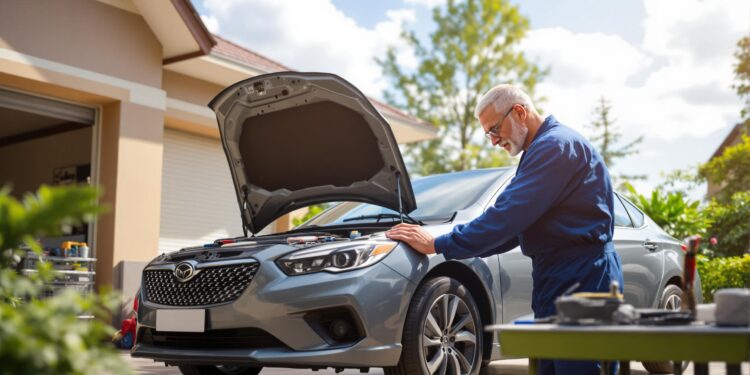Over 80% of cars on Ugandan roads are second-hand imports, and hidden issues can lead to denied insurance claims (15% in 2022) or safety risks. Here’s a 10-point checklist to ensure your purchase is safe, legal, and worth the investment:
Key Areas to Inspect:
- Exterior: Rust, body repairs, tire wear, and lights.
- Interior: Seats, dashboard, air conditioning, and electricals.
- Engine & Mechanics: Fluid levels, engine sound, and test drive performance.
- Documentation: Verify ownership, roadworthiness, and service history.
Quick Facts:
- 37% of imported cars fail initial inspections due to body damage.
- 42% of accidents in 2023 were linked to poor vehicle conditions.
- Professional inspections cost UGX 150,000–300,000 and uncover hidden issues in 37% of cars.
Pro Tip: Always cross-check documents with URA and ensure the car has a valid UNBS roadworthiness certificate. Ready to dive deeper? Let’s break it all down.
INSPECT Like a PRO! The BEST Way to Check a Used Car
Exterior Check
Inspecting the exterior of a used car is essential, especially in Uganda, where tough weather and road conditions can take a toll on vehicles. The Uganda Revenue Authority found that 37% of imported used cars had major exterior problems during their 2023 border inspections [1].
Body Condition
Look over the car’s body in natural daylight for a clear view. A magnet can help detect areas with body filler – if it doesn’t stick, that spot might have been repaired. Focus on these key areas:
- Panel alignment: Uneven gaps around doors, the hood, or the trunk may signal past accidents.
- Paint consistency: Watch for mismatched colors or overspray on rubber seals.
- Rust spots: Common trouble areas include wheel arches and door sills, especially on models like the Toyota Corolla.
- Structural integrity: Ripples or waves in the panels can hint at hidden damage.
"A thorough exterior inspection can reveal a vehicle’s true history and potential future problems. In Uganda’s harsh climate, paying attention to rust and paint condition is crucial." – John Mugisha, Head of Vehicle Inspection at UNBS [3]
Tires and Wheels
Tires tell a story about how well the car was maintained. They should meet the UNBS minimum tread depth of 1.6mm [2]. Uneven wear patterns can point to deeper issues:
| Wear Pattern | What It Means |
|---|---|
| Center wear | Over-inflation |
| Edge wear | Under-inflation |
| One-sided wear | Alignment problems |
| Cupping/scalloping | Worn suspension |
Lights and Glass
Don’t overlook the lights and glass. Here’s what to check:
- Lights: Ensure they work properly, look for moisture inside the housings, and check for cracks or mismatched colors between pairs.
- Windows and mirrors: Inspect for chips or cracks that might worsen, test power windows, and check windshield seals for leaks. Also, confirm that mirrors adjust as they should.
Faulty lights and worn tires are no small issues – 42% of road accidents in 2023 were linked to poor vehicle conditions like these, according to UNBS [2].
Once you’ve completed the exterior review, move on to assessing the interior for comfort and functionality.
Interior Check
The condition of a car’s interior can reveal how well it’s been maintained and might even hint at hidden mechanical or structural problems. According to the Uganda Motor Industry Association, 68% of used cars imported to Uganda in 2022 had at least one interior defect [4].
Seats and Upholstery
Take a close look at all the seats, especially the driver’s seat, as it tends to show the most wear. The Uganda Standard (US 845:2008) specifies that all safety features, such as seat belts and anchors, must be in working order [5].
| Area to Inspect | Potential Issues | What It Suggests |
|---|---|---|
| Seat fabric/leather | Tears, fading | Exposure to sun, poor upkeep |
| Cushioning and mechanisms | Sagging, stuck adjusters | Heavy use, possible damage |
| Seat belts | Fraying, weak retraction | Compromised safety features |
"In Uganda’s humid climate, check for dampness under floor mats and mold, especially during rainy seasons", advises David Nsamba, Chief Inspector at the Uganda Automobile Association [6].
Dashboard and Controls
A study revealed that 29% of used cars in Uganda have issues with electrical components [4]. Pay attention to the following:
- Warning lights should turn on briefly during startup and go off afterward.
- Gauges need to respond correctly as the engine runs.
- Test all switches and buttons to ensure they work.
- Verify that the horn is loud and effective.
- Check that the windshield wipers function properly at all speeds.
Air Conditioning and Heating
Given Uganda’s often hot climate, a reliable air conditioning system is a must. However, 42% of used cars imported into the country have faulty air conditioning [4]. Here’s what to check:
- Run the air conditioner for 15 minutes; it should start cooling within 30 seconds.
- Ensure airflow is steady from all vents.
- Listen for any unusual noises from the compressor.
- Watch out for musty smells, which could signal mold.
- Confirm that all fan speeds and temperature settings work correctly.
After finishing your interior inspection, it’s time to move on to the engine and mechanical systems to uncover any other potential concerns.
Engine and Mechanical Check
Mechanical issues are a major concern for used car buyers in Uganda, with 42% of complaints linked to these problems, according to the Uganda Motor Industry Association [4]. To avoid costly repairs later, a detailed engine and mechanical inspection is essential before making your purchase.
Engine Condition
The engine’s performance is key to the vehicle’s reliability and upkeep costs. Focus on these critical areas during your inspection:
| Component | What to Check | Warning Signs |
|---|---|---|
| Engine Sound | How the engine starts when cold | Knocking or rattling |
| Exhaust | Smoke and emissions | Black smoke (fuel issues) |
| Engine Belts | Condition and tension | Visible wear or damage |
| Engine Bay | Overall condition | Fluid leaks, residue |
"In Uganda’s climate, pay special attention to cooling system components. A clean engine bay often indicates better maintenance practices and can help spot potential issues more easily", says James Mukasa, Senior Technician at AutoXpress Uganda [4].
Fluid Levels and Quality
Uganda Standards (US 845:2017) highlights the importance of checking fluid levels and quality [4]. Here’s what to look for:
| Fluid Type | Condition Check |
|---|---|
| Engine Oil | Amber to light brown; avoid black or gritty oil |
| Coolant | Clear with consistent color; avoid rusty or cloudy fluid |
| Brake Fluid | Clear to slightly yellow; avoid dark fluid |
| Power Steering | Clear to light amber; avoid dark or foamy fluid |
Test Drive
A proper test drive can reveal 73% of mechanical issues, according to recent studies [6]. Spend 30-45 minutes driving under different conditions to assess the car’s performance.
During the test drive, check for:
- Smooth acceleration and steady idle
- Gear changes without delays or grinding
- Firm, responsive braking
- Steering precision and ease of control
"Most Ugandan roads present unique challenges. Test the vehicle on both tarmac and unpaved roads to get a complete picture of its mechanical condition", advises Peter Ochieng, Lead Inspector at the Uganda Vehicle Testing Authority [4].
For added peace of mind, bring basic inspection tools or hire a professional to assist with the evaluation. Once you’re confident in the car’s mechanical soundness, you can move on to verifying its legal and ownership details.
sbb-itb-7bab64a
Documentation and Legal Check
After completing your mechanical inspection, verifying the paperwork is a must when purchasing a used car in Uganda. Paperwork issues account for 27% of used car disputes, so this step is critical.
Vehicle Registration and Ownership
Make sure to confirm these documents through official channels:
| Document Type | What to Check | Where to Verify |
|---|---|---|
| Vehicle Logbook | Chassis and engine numbers | URA online portal |
| Current License | Expiry date, owner details | SMS to 8888 |
| Import Documents | Customs clearance, age compliance | URA office |
| Previous Owner ID | Matches logbook details | Physical inspection |
"Always verify document authenticity through URA’s online system before proceeding with any payment. We’ve seen a significant increase in forged documentation cases over the past year", says Sarah Namuli, Senior Vehicle Registration Officer at URA [1].
Service History
Compare the service records to the car’s mileage and wear from your earlier checks. Look for:
- Regular Maintenance: Stamps from authorized service centers with dates.
- Major Repairs: Clear documentation of repairs and parts used.
- Mileage Records: Consistent progression across services.
- Warranty Work: Official paperwork from the dealer.
Roadworthiness Certification
Since November 22, 2024, the UNBS has enforced stricter roadworthiness checks for imported used cars. The inspection fee is UGX 514,957 (as of 2025). The process includes:
- Emissions and safety checks.
- Issuance of an electronic certificate.
- A mandatory windshield sticker.
To confirm the certification:
- Use the UNBS mobile app to scan the QR code on the certificate.
- Contact UNBS directly with the certificate number.
- Inspect the security features on the windshield sticker.
Vehicles that fail to meet these requirements risk penalties and invalid insurance. Once all documentation is verified, proceed to the final negotiations, ensuring every legal detail is in order.
Professional Inspection
While personal checks are helpful, professional assessments bring a deeper level of expertise and accuracy. Certified Ugandan mechanics use advanced tools to uncover problems that might not be visible during a casual inspection:
| Diagnostic Tool | Purpose | What It Reveals |
|---|---|---|
| OBD-II Scanner | Engine diagnostics | Error codes, hidden performance issues |
| Compression Tester | Engine health check | Problems within engine cylinders |
| Ultrasonic Gauge | Body inspection | Signs of hidden damage or repairs |
| Thermal Imaging | System analysis | Overheating parts or failing systems |
"A professional inspection is not an expense, it’s an investment in peace of mind and financial security when buying a used car in Uganda", says John Mukasa, Head of Vehicle Inspections at Uganda Automobile Association [1].
Cost of Inspection in Uganda
Inspection fees in Uganda depend on the level of service and the type of vehicle being checked:
| Service | Cost (UGX) | Scope |
|---|---|---|
| Basic Inspection | 150,000 | Visual assessment, basic diagnostics |
| Standard Inspection | 200,000 | OBD scanning, fluid checks |
| Comprehensive | 300,000 | Full diagnostics, road testing included |
The Uganda Motor Industry Association highlights that professional inspections uncovered serious issues in 37% of used cars that initially seemed problem-free to buyers. To ensure reliability, confirm the inspector’s credentials and verify their compliance with UNBS standards, particularly US 845:2017 for vehicle inspections.
With a thorough professional inspection and verified documentation, you can approach negotiations with confidence.
Conclusion
When wrapping up your used car purchase, keep these crucial factors in mind to make an informed decision:
Key Points
A successful used car purchase relies on checking three main areas:
- Legal documentation: Ensure all paperwork is in order and complies with regulations.
- Mechanical condition: Get a professional diagnostic to confirm the car’s reliability.
- Physical state: Inspect the vehicle’s condition to assess its long-term value.
Statistics show that systematic inspections can lower the chances of mechanical issues in the first year by 67%. Pay close attention to a car’s age – vehicles nearing 13 years often need extra care during documentation reviews.
Final Tips
Here are some Uganda-specific strategies to guide your decision:
- Focus on thorough inspections for cars over 8 years old.
- Cross-check service records against UNBS certification dates to verify maintenance claims.
- Ensure all documentation is complete to simplify future resale.
- Confirm the availability of spare parts through local dealerships. Models like the Toyota Hilux and Nissan Patrol tend to have better parts accessibility.
- Use your inspection checklist to negotiate a fair price. Documented issues can often justify a 5–15% discount.
Look for vehicles that offer:
- Comprehensive service records that align with the mileage.
- Valid UNBS certification.
- Original import documentation.
- An established spare parts network.
With Uganda’s growing number of automated vehicle inspection stations [7], take advantage of these facilities to add a professional layer to your personal assessment. A thorough inspection ensures both safety and a better resale value down the line.
FAQs
How to clear an imported car in Uganda?
Once your inspection is done, here’s the process for clearing your imported car (usually takes 3-5 days):
| Required Document | Purpose |
|---|---|
| Original Bill of Lading | Proof of shipping ownership |
| Commercial Invoice | Indicates the vehicle’s purchase value |
| Pre-Import Verification Certificate | Confirms the car meets required standards |
| Original Passport | Confirms the importer’s identity |
| Import Declaration Form | Provides import details |
Make sure to double-check these documents against the seller’s paperwork from your initial inspection.
"Proper preparation and adherence to URA guidelines streamline vehicle clearance." – Sarah Nakimera, URA [1]
Taxes and Fees:
- 25% import duty (based on CIF value)
- 18% VAT (calculated on CIF + duties)
- 1.5% infrastructure levy
- An environmental levy (varies with the car’s age)
Keep in mind, if additional inspections are required, the process may take 7-10 days. To make things smoother, work with clearing agents who know URA procedures well. You can also use URA’s online tax calculator to get an estimate of the costs.
Ensure all clearance steps are completed before finalizing the purchase to avoid any legal issues.
Related Blog Posts
- SUV vs Sedan: Best Choice for Ugandan Roads
- Common Car Problems in Uganda: Solutions Guide
- Top 7 Platforms for Buying Car Parts Online in Uganda
- 10 Safety Tips for Long Drives in Uganda




